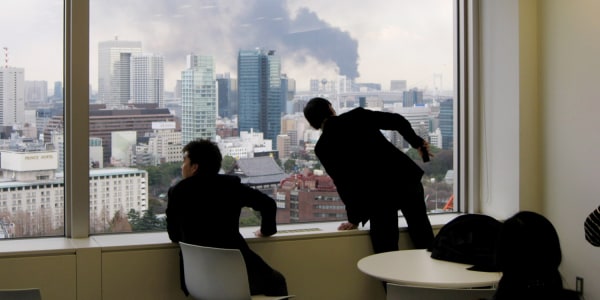With a minute of silence, prayers and anti-nuclear rallies, Japan marked on Sunday the first anniversary of an earthquake and tsunami that killed thousands and set off a radiation crisis that shattered public trust in atomic power and the nation's leaders.
A year after the magnitude 9.0 earthquake unleashed a wall of water that hit Japan's northeast coast, killing nearly 16,000 and leaving nearly 3,300 unaccounted for, the country is still grappling with the human, economic and political costs.
Along the coast, police and coastguard officers, urged on by families of the missing, still search rivers and shores for remains even though the chances of finding any would appear very slim.
In the port of Ofunato, hundreds of black-clad residents gathered at the town hall to lay white chrysanthemums at an altar dedicated to the town's 420 dead and missing.
"I'm unable to wipe away the sense of regret of having lost my mother and wife because we underestimated the tsunami," said Kosei Chiba, 46, who owns a petrol station.
"We can't just stay sad. Our mission is to face reality and move forward step by step. But the damage the town suffered was too big and our psychological scars are too deep. We need a long time to rebuild."
Just a half a mile from Tokyo Electric Power Company's (Tepco) wrecked Fukushima plant, where reactor meltdowns triggered the world's worst nuclear crisis since Chernobyl, residents of the abandoned town of Okuma were allowed back for a few hours to honor the dead.
"It was a wonderful place. If it wasn't for all that's happened, I'd be able to come back. But thanks to Tepco, I wasn't even able to search for the bodies of my relatives," said Tomoe Kimura, 93, who lost four members of her family in the tsunami, two of whom were never found.
Authorities have imposed a 12-mile no-go zone around the plant and residents may never be allowed back.
Along the northeast coast, police and coastguard officers, urged on by families of the missing, still search rivers and shores for remains even though the chances of finding any appear very slim.
The nation observed a moment of silence at 2:46 p.m. (12:46 a.m. EST) when the quake struck.
In the devastated northeastern coastal town of Rikuzentakata, a siren sounded and a Buddhist priest in a purple robe rang a huge bell at a damaged temple overlooking a barren area where houses once stood.
At the same time in Tokyo's National Theater, Emperor Akihito, Empress Michiko and Prime Minister Yoshihiko Noda stood in silence with hundreds of other people dressed in black at a memorial service.
Ofunato was to pause again 33 minutes later to mark when a 75-foot tsunami ripped through this town of 41,000.
The Japanese people earned the world's admiration for their composure, discipline and resilience in the face of the disaster while its companies impressed with the speed with which they bounced back, mending torn supply chains.
As a result, the economy looks set to return to pre-disaster levels in coming months with the help of about $230 billion earmarked for a decade-long rebuilding effort agreed in rare cooperation between the government and the opposition.
"In recent history, Japan seized rapid economic expansion from the ashes and desolation of World War Two, and we built the most energy-efficient economy in the world in the aftermath of the oil shock," Noda said in an article published in the Washington Post.
"On the anniversary of the Great East Japan Earthquake, we remember that today we face a challenge of similar proportions."
Today, some 325,000 people rendered homeless remain in temporary housing. While much of the debris has been gathered into massive piles, very little rebuilding has begun.
"I wish I could go back to my old house and get back our normal life again," said Hyakuaiko Konno, a 64-year-old woman from the Ishinomaki coast who has been living in temporary housing for the past seven months.
The government says the damaged Fukushima Dai-ichi nuclear plant, where three reactor cores melted down after the tsunami knocked out their vital cooling systems, is stable and that radiation coming from the plant has subsided significantly. But the plant's chief acknowledged to journalists visiting the complex recently that it remains in a fragile state, and makeshift equipment — some mended with tape — could be seen keeping crucial systems running.
An anti-nuclear protest was also planned in downtown Tokyo on Sunday amid growing public opposition to atomic power in the wake of the disaster, the worst since Chernobyl in 1986.
Only two of Japan's 54 reactors are now running while those shut down for regular inspections undergo special tests to check their ability to withstand similar disasters. They could all go offline by the end of April if none are restarted before then.
The Japanese government has pledged to reduce reliance on nuclear power, which supplied about 30 percent of the nation's energy needs before the disaster, but says it needs to restart some nuclear plants to meet Japan's energy needs during the transition period.
